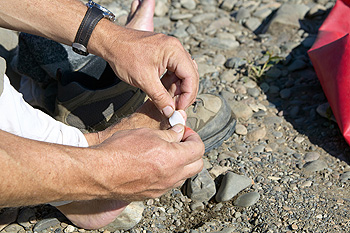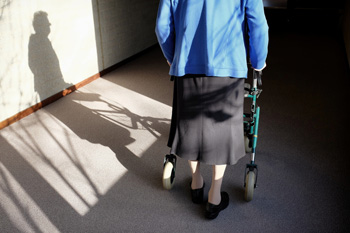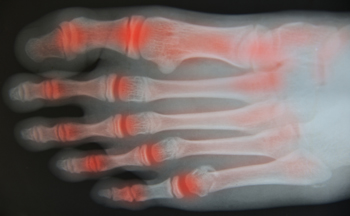Items filtered by date: July 2022
Infections Can Sometimes Be the Cause of Your Ankle Pain

There are many reasons why your ankle may hurt. You may have sprained, strained, or fractured your ankle, or ruptured your Achilles tendon. Perhaps some form of arthritis has settled into the ankle joint, or you may have fallen arches. A less common reason for ankle pain is an infection. You are more susceptible to developing an infection in your ankle if you have recently had surgery or have suffered a cut or other form of trauma in the area, and bacteria entered through the open skin. A painful ankle infection is sometimes accompanied by warmth, swelling, or redness in the affected area as well as fever and fatigue. Any infection is a potentially serious condition and should be attended to promptly. If you are having any of the symptoms mentioned here, it is suggested to make an appointment with a podiatrist. They will examine your ankle and make an accurate diagnosis in order to treat the condition properly.
Ankle pain can have many different causes and the pain may potentially be serious. If you have ankle pain, consult with Dan Kirk, DPM from Bluffton Foot & Ankle. Our doctor will assess your condition and provide you with quality foot and ankle treatment.
Ankle pain is any condition that causes pain in the ankle. Due to the fact that the ankle consists of tendons, muscles, bones, and ligaments, ankle pain can come from a number of different conditions.
Causes
The most common causes of ankle pain include:
- Types of arthritis (rheumatoid, osteoarthritis, and gout)
- Ankle sprains
- Broken ankles
- Achilles tendinitis
- Achilles tendon rupture
- Stress fractures
- Tarsal tunnel syndrome
- Plantar fasciitis
Symptoms
Symptoms of ankle injury vary based upon the condition. Pain may include general pain and discomfort, swelling, aching, redness, bruising, burning or stabbing sensations, and/or loss of sensation.
Diagnosis
Due to the wide variety of potential causes of ankle pain, podiatrists will utilize a number of different methods to properly diagnose ankle pain. This can include asking for personal and family medical histories and of any recent injuries. Further diagnosis may include sensation tests, a physical examination, and potentially x-rays or other imaging tests.
Treatment
Just as the range of causes varies widely, so do treatments. Some more common treatments are rest, ice packs, keeping pressure off the foot, orthotics and braces, medication for inflammation and pain, and surgery.
If you have any questions, please feel free to contact our offices located in Bluffton and Celina, OH . We offer the newest diagnostic and treatment technologies for all your foot care needs.
Various Ways to Get a Blister

A blister that forms on the skin of the feet is a common response to excess friction from shoes, or from an injury. It is defined as the body’s natural defense mechanism to protect damaged skin. A small area that is filled with liquid can form over the raw skin, and this protects the skin as new skin develops. It is important to cover the blister, and this can help to avoid premature popping. A loose elastic bandage generally works well, or some people use a padded bandage. When new skin has grown, the blister is no longer needed, and will gradually drain. Common reasons for patients to develop blisters can include wearing shoes that do not fit correctly, having an allergic reaction, or possibly from severe sunburn. Additionally, blisters may form from wearing damp socks, and it can help to wear socks that can absorb moisture. If a chemical spills on the feet, the result may be a blister forming. If you have blisters on your feet that are recurring, or if a blister has become infected, it is suggested that you consult with a podiatrist who can help you with treatment options.
Blisters may appear as a single bubble or in a cluster. They can cause a lot of pain and may be filled with pus, blood, or watery serum. If your feet are hurting, contact Dan Kirk, DPM of Bluffton Foot & Ankle. Our doctor can provide the care you need to keep you pain-free and on your feet.
Foot Blisters
Foot blisters are often the result of friction. This happens due to the constant rubbing from shoes, which can lead to pain.
What Are Foot Blisters?
A foot blister is a small fluid-filled pocket that forms on the upper-most layer of the skin. Blisters are filled with clear fluid and can lead to blood drainage or pus if the area becomes infected.
Symptoms
(Blister symptoms may vary depending on what is causing them)
- Bubble of skin filled with fluid
- Redness
- Moderate to severe pain
- Itching
Prevention & Treatment
In order to prevent blisters, you should be sure to wear comfortable shoes with socks that cushion your feet and absorb sweat. Breaking a blister open may increase your chances of developing an infection. However, if your blister breaks, you should wash the area with soap and water immediately and then apply a bandage to the affected area. If your blisters cause severe pain it is important that you call your podiatrist right away.
If you have any questions, please feel free to contact our offices located in Bluffton and Celina, OH . We offer the newest diagnostic and treatment technologies for all your foot care needs.
Elderly Foot Care and Moisturizer

As an individual ages, it becomes increasingly important for them to take special care of their feet. This is because seniors tend to have feet that are more prone to dryness and inadequate blood circulation. Therefore, seniors ought to think critically about their daily foot care routine and how they are going about maintaining strong feet. One important component of a senior’s foot care routine is moisturizing the feet. Since seniors generally have drier feet than children and younger adults, choosing and applying the right foot moisturizer is essential. Keeping their feet hydrated can also help seniors prevent cracked heels and ward off potential infections. When applying moisturizer to the feet, a senior might be careful not to apply moisturizer that is too greasy, as this may put them at a greater risk of falling and tripping. A senior might also be mindful that standard moisturizers that have a pleasant fragrance sometimes fail to provide the needed hydration. Instead, seniors could select a heavy duty moisturizer that is not too greasy but can still sufficiently hydrate the skin. For more tips on how seniors can care for their feet, consider contacting a podiatrist.
Proper foot care is something many older adults forget to consider. If you have any concerns about your feet and ankles, contact Dan Kirk, DPM from Bluffton Foot & Ankle. Our doctor can provide the care you need to keep you pain-free and on your feet.
The Elderly and Their Feet
As we age we start to notice many changes in our body, but the elder population may not notice them right away. Medical conditions may prevent the elderly to take notice of their foot health right away. Poor vision is a lead contributor to not taking action for the elderly.
Common Conditions
- Neuropathy – can reduce feeling in the feet and can hide many life-threatening medical conditions.
- Reduced flexibility – prevents the ability of proper toenail trimming, and foot cleaning. If left untreated, it may lead to further medical issues.
- Foot sores – amongst the older population can be serious before they are discovered. Some of the problematic conditions they may face are:
- Gouging toenails affecting nearby toe
- Shoes that don’t fit properly
- Pressure sores
- Loss of circulation in legs & feet
- Edema & swelling of feet and ankles
Susceptible Infections
Diabetes and poor circulation can cause general loss of sensitivity over the years, turning a simple cut into a serious issue.
If you have any questions please feel free to contact our offices located in Bluffton and Celina, OH . We offer the newest diagnostic and treatment technologies for all your foot and ankle needs.
Are Bunions Affecting Your Everyday Life?
Easing Foot Pain From Rheumatoid Arthritis

When you spend a lot of your time on your feet there is a good chance that you will experience foot pain at some point. This likelihood increases when you have rheumatoid arthritis. Experts say that most people with rheumatoid arthritis have daily pain in the feet and ankles. Rheumatoid arthritis (RA) is an autoimmune disease that attacks the joints in your body, specifically the synovial fluid that keeps the joints moving smoothly. Since the feet and ankles have so many joints they are common targets, causing inflammation, swelling, and pain. Being overweight compounds the problem of rheumatoid arthritis by adding more pressure to the foot and ankle joints. As a result, lower-impact exercises such as swimming, biking, and yoga are recommended as a way to maintain a healthy weight. Several specific exercises can help as well as wearing shoes with deep cushioning and a wider base. In addition, certain medications are available to confront the pain of RA flare-ups. If you have foot or ankle pain from rheumatoid arthritis that interferes with your daily activities, it is suggested to see a podiatrist for treatment options that work best for you.
Because RA affects more than just your joints, including the joints in your feet and ankles, it is important to seek early diagnosis from your podiatrist if you feel like the pain in your feet might be caused by RA. For more information, contact Dan Kirk, DPM of Bluffton Foot & Ankle. Our doctor will assist you with all of your podiatric concerns.
What Is Rheumatoid Arthritis?
Rheumatoid Arthritis (RA) is an autoimmune disorder in which the body’s own immune system attacks the membranes surrounding the joints. Inflammation of the lining and eventually the destruction of the joint’s cartilage and bone occur, causing severe pain and immobility.
Rheumatoid Arthritis of the Feet
Although RA usually attacks multiple bones and joints throughout the entire body, almost 90 percent of cases result in pain in the foot or ankle area.
Symptoms
- Swelling and pain in the feet
- Stiffness in the feet
- Pain on the ball or sole of feet
- Joint shift and deformation
Diagnosis
Quick diagnosis of RA in the feet is important so that the podiatrist can treat the area effectively. Your doctor will ask you about your medical history, occupation, and lifestyle to determine the origin of the condition. Rheumatoid Factor tests help to determine if someone is affected by the disease.
If you have any questions please feel free to contact our offices located in Bluffton and Celina, OH . We offer the newest diagnostic and treatment technologies for all your foot and ankle needs.

